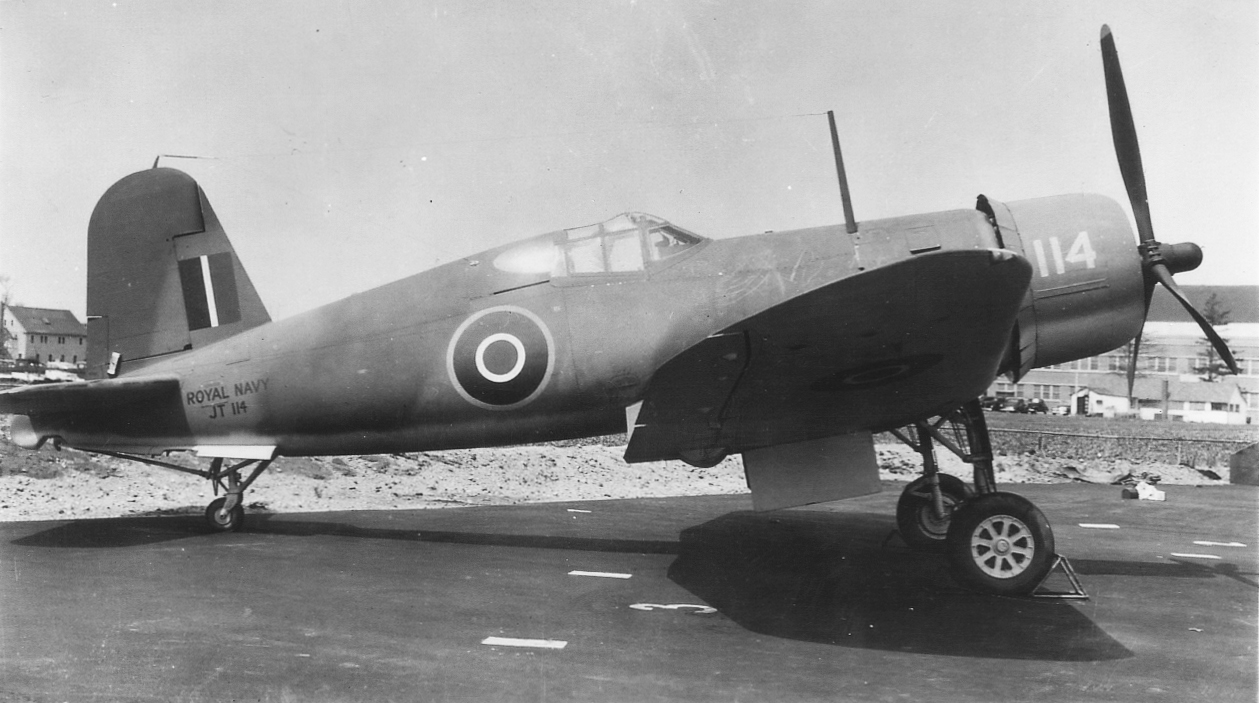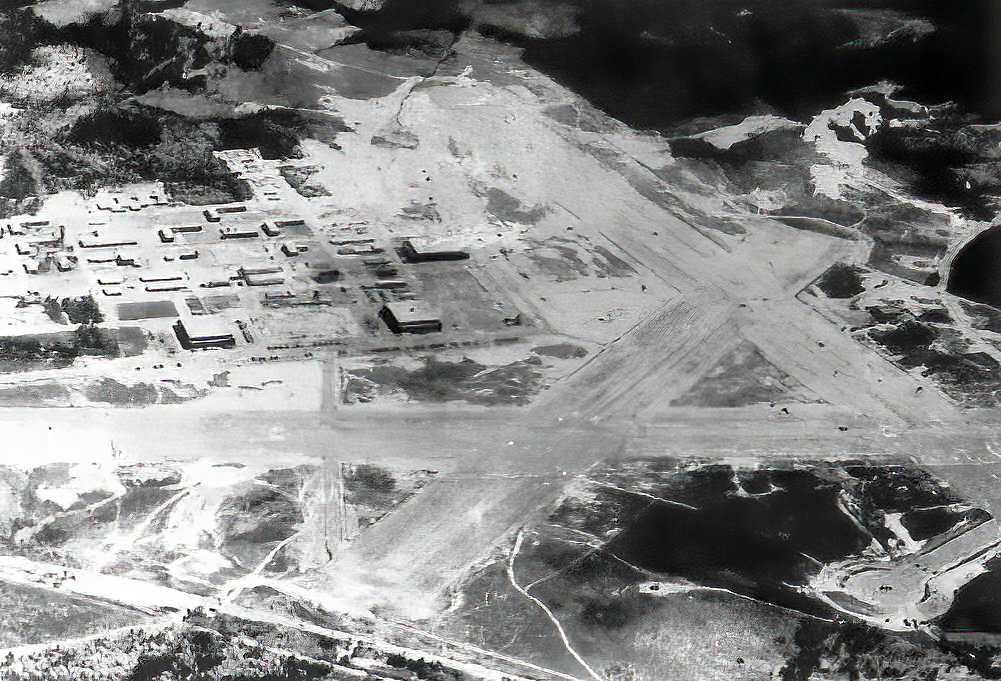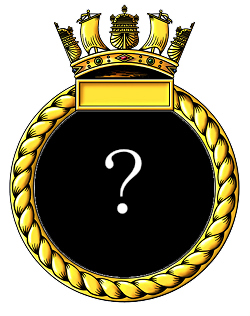



No.1831 squadron officially formed in the United States at US Naval Air Station Quonset Point, Rhode island, on July 1st 1943 as a single seater fighter squadron under the command of Lt. Cdr. H. P. Allingham RNR. Initial equipment was 10 Corsair Is. After familiarisation with the aircraft and equipment the squadron began training in earnest to prepare for active service.
While at Quonset Point there were two serious incidents involving the Pratt & Whitney Double Wasp R-2800-8 engine; on July 12th Corsair JT137 ditched in Narraganset Bay, off Pt. Judith, after its engine failed, the pilot, Sub-Lt R. Fullerton RNVR was rescued unhurt by a fishing vessel. On the 21st Corsair JT138 caught fire in flight and exploded at 3000 feet; the pilot, , Sub-Lt D. .N. Lovely RNVR was killed when his parachute failed to open, the aircraft crashed in the Sakonnet River.

The Chance-Vought F4U-1 Corsair Mk.I
The squadron moved to US Naval Air Station Brunswick, Maine on August 23rd to continue their training, during their stay here some Deck Landing Training (DLT) was carried out on the training carrier USS CHARGER in late September; the squadron C.O. Lt. Cdr. Allingham is recorded as suffering a barrier crash during a DLT session on the 29th in Corsair JT235. There was one other flying incident while training at Brunswick, Sub-Lt. D. S. Byrne RNZNVR made a wheels-up landing in Corsair JT130 on September 14th.
The squadron arrived at US Naval Air Station Norfolk on October 4th to await the escort carrier HMS TRUMPETER, the carrier which was allocated to ferry them to the UK. She arrived at Norfolk Naval Dockyard on the 6th for repairs and modifications to be carried out. The Corsairs of 1831 squadron were hoisted aboard on the 6th and stowed in the hanger; they were joined by the 10 Corsairs of 1833 squadron the 17th. The corsairs were to be non-operational for this voyage, the ship had already embarked 848 squadron’s Avenger Torpedo Bombers on September 4th and they had worked up with the ship and would provide anti-submarine patrols during the Atlantic crossing. On completion of loading TRUMPETER sailed for New York on the morning of the 17th. On arrival at New York on the 19th the ship spent a further three days under repair before sailing with convoy U.T.4 on the 21st in company with Sister CVE HMS SLINGER and the aircraft transport ATHENE for passage to the UK.
Both 1831 1833squadrons were disembarked at RNAS Belfast on November 1st before flying to RNAS Stretton on the 3rd. Five days later on November 8th the squadron joined the new 15th Naval Fighter Wing which comprised of 1830, 1831 and 1833 Corsair squadrons for service in HMS Illustrious. In early December it was decided to reduce the Wing to two squadrons and1831 was disbanded at Stretton on December 10th 1943, its equipment and aircrews being split up between Nos.1830 and 1833 Squadrons.
1831squacron formed again as a single seater fighter squadron at US Naval Air Station Brunswick, Maine on November 1st 1944. This new squadron was issued with 18 Corsair IVs and was commanded by Lt. Cdr. (A) R. W. M. Walsh RN.
Training included navigation exercises, low flying, formation flying and combat tactics, the squadron briefly moving to US Naval Auxiliary Airfield Bar Harbour, Maine on December 2nd for six days of Aerodrome Dummy Deck Landing (ADDL) training returning to Brunswick on completion. On December 20th they flew to US Naval Air Station Norfolk for an eight day stay while the pilots undertook Deck Landing Training (DLT), flying out to the training carrier, the USS CHARGER operating in Chesapeake Bay. Only one deck crash is recorded for this period, Sub-Lt. J. F. Burstall RNVR suffered a barrier crash in KD640 on the 22nd. On completion of the DLT sessions the squadron returned to Brunswick where they remained until the end of January 1945.
On completion of working up at USNAS Brunswick the squadron flew to US Naval Air Station Norfolk on January 31st 1945 to embark in the escort carrier HMS PURSUER for passage to the UK. The aircraft were embarked on February 1st and stowed in the hangar [1] PURSUER sailed from Norfolk at 17:39 on February 4th and arrived in Belfast on the 16th where her ferry load was disembarked to RNAS Belfast; the aircraft of 1831 arrived at RNAS Eglinton. Northern Ireland on February 18th.

U.S. Naval Air Station Brunswick, Maine.
Training continued at Eglinton in preparation for joining a carrier. One formation flying exercise on March 24th had two near collisions; KD423 flown by Sub-Lt. R. W. H. Boyns RNVR was hit by the prop of KD570, pilot unknown, and KD499 flown by Sub-Lt. L. G V. Behn RNVR was also struck on the fuselage by the prop of KD549 flown by Sub-Lt. A. Jackson. All aircraft landed safely. The only other incident recorded for this period was a wheels-up landing on April 3rd, Sub-Lt. Behn had been carrying out ADDLs in KD512, it is unclear if there was a mechanical failure or pilot error.
At the start of May the squadron strength was increased to 21 aircraft before joining the Light Fleet Carrier HMS GLORY for service with the British Pacific Fleet. The ship had just completed her builder’s sea trials and had commissioned on April 2nd 1945. The Admiralty had decided at the beginning of the year that due to the threat of U-Boat attack in the traditional training areas in the Irish Sea the new ‘Colossus’ class Light Fleet Carriers would work-up to operational readiness in the Mediterranean. The squadron departed from Eglinton for Renfrew airport on May 9th, in transit to join GLORY at sea on the 11th. They were joined on board by the 18 Barracuda IIs of 837which embarked on the same day; this squadron had previously embarked during April to put the ship’s flight deck
Once her squadrons were aboard GLORY sailed for the Mediterranean; arriving at Malta on May 22nd she disembarked 1831 to RNAS Hal Far; the squadron lost its first aircraft of the deployment while disembarking at Malta, Sub-Lt. M. P. W. Stone RNVR in KD535 closed his throttle on take-off then sank into the sea, he was picked up by the attending destroyer HMS TUSCAN. Glory sailed in company with her sister ships COLOSSUS, VENGEANCE, VENERABLE, and the destroyers TUSCAN and TYRIAN for Alexandria the following day.
837 flew ashore to RNAS Dekheila, Egypt on the 24th, COLOSSUS, VENGEANCE, and VENERABLE arrived at Alexandria on the 25th but GLORY returned to Malta and re-embarked 1831 on the 26th to commence flying training and other exercises as the ship began her work-up. While ashore Corsair KD741 was involved in a collision at night when Hurricane LB179 taxied into Lt. R. W. M. Walsh’s aircraft which was stationary without lights. On the 30th Sub-Lt. J.F. Burstall RNVR made the first barrier crash, he made a fast approach in KD514, caught the last wire but continued on into the barrier. Over the next three weeks of intensive training there were three more accidents; on June 1st Lt. F. J. Golightly RNVR stalled over the deck in KD443 during DLT and swung to Port causing his Port wheel to run off the deck edge into the netting. Sub-Lt. Boyns in KD441 also had a problem during DLT on the 2nd, he swung to Starboard and his Starboard wing tip hit the ship’s crane. On the 18th Sub-Lt. A. W. Findlay RNVR had a barrier crash when KD629 caught No. 8 wire but failed to be arrested. By this time the ship was operating off Alexandria and the squadron was flown ashore to RNAS Dekheila on the 18th. Flying continued with aircraft flying out to operate from the ship; there was one final accident of the work-up on the 23rd when KD441, ranged for take-off, ran backwards into the prop of KD396 manned by Sub-Lt. K. J. Toms RNVR.

THe Deck Landing Control Officer (DCLO) or "Bata" guides a corsair in to land on GFLORY
The Barracudas of 837 re-embarked in GLORY on June 25th 1945 having increased their equipment strength to 12 aircraft, and on June 30th the two squadrons formed the new 16th Carrier Air Group under the command of Major A .J. Wright Royal Marines. 1831 re-embarked on July 2nd before the ship proceeded to Port Said to transit the Suez Canal on passage to Trincomalee, Ceylon.
Once the ship was off the Ceylonese coast on the 15th, both squadrons flew ashore to RNAS Katukurunda while the ship preceded to Trincomalee harbour. The stay ashore was short, both squadrons re-embarking on July 27th when GLORY sailed for Sydney, Australia to join the British Pacific Fleet.
On August 2nd Lt Boyns assumed command of the squadron and flying operations continued during the passage, almost without incident for 1831, there was one barrier crash on August 8th by Lt. M. C. Tait RNVR in KD537. The ship was off the coast of Australia when the news of the Japanese surrender was announced on August 15th 1945; her Air Group disembarked to RNAS Schofields, New South Wales the following day.
On August 25th the Australian Commonwealth Naval Board asked Admiral Sir Bruce Fraser, C-in-C British Pacific Fleet, whether a cruiser or larger vessel could be made available to accept the surrender of the Japanese forces in the Bismarck Archipelago, the Solomons and New Guinea. GLORY was chosen for this operation and she sailed on September 1st as part of BPF Task Group 111.5, with the Sloops HART and AMETHYST for Rabaul on the island of New Britain, re-embarking her squadrons once clear of the harbour.
The ships and squadrons maintained wartime readiness on route as a precaution; it was believed some resistance could be encountered ahead of the main surrender ceremony in Tokyo Bay planned for September 2nd and that some Japanese forces may not observe the cease fire. Arriving at Rabaul in the forenoon on September 5th GLORY flew off a detachment of Corsairs from 1831 to operate ashore at Royal Australian Air Force Station Jacquinot Bay, New Britain. [2]
T.G. 111.5 was joined by the Australian Destroyer VENDETTA and Corvettes KIAMA, DUBBO, LITHGOW and TOWNSVILLE. The formal surrender of Japanese forces in the area took place aboard the flight deck of HMS GLORY on September 6th 1945 and was accepted by Australian General V.A.H. Sturdee. Representing the Japanese were General H. Imamura, Commander 8th Army Area, Admiral J. Kusaka, Commander South East Area Fleet.On her return to Australia on September 11th GLORY disembarked 837 and the remaining aircraft of 1831 to RNAS Jervis Bay in New South Wales. The ship was to be employed on repatriation duties, sailing from Sydney on September 26th for Manila to collect former Canadian POWs for passage home to Vancouver via Hawaii. She delivered her passengers to the RCN base at Esquimalt on October 26th. She departed on November 5th for Hong Kong, Manila abs other ports on the return leg to Sydney, arriving back on December 12th carrying former Australian POWs.
Ashore in Australia flying training continued at Jervis Bay with a further two accidents occurring during the remainder of September; on the 17th Sub-Lt. R. Phillips RNVR in KD565 had both main wheels lock up on landing, the aircraft overturned, the pilot was OK. Sub-Lt. W. R. Hodkinson RNVR suffered an engine fire at 500 feet in KD219 and ditched in Jervis Bay on the 21st. The 16th C.A.G. moved to RNAS Nowra on October 29th, RNAS Jervis Bay was running down to closure. 837 were to re-equip here, exchanging their Barracudas for Fireflies. Sub-Lt. Boyns had a serious crash in KD449 on November 6th, when his aircraft nosed over trapping him underneath.
After spending Christmas 1945 at Nowra the Air Group began preparations to re-embark in GLORY in the New Year and deck landing practice was done with the ship in early January; Sub-Lt. J. Aston RNVR made a bad deck landing on the 7th in KD736, the aircraft stalled on landing and the Port wingtip struck the Deck Landing Control Officer. Two aircraft, KD905 and KD951 were damaged in the hangar aboard GLORY on the 9th. Her Air Group re-embarked on January 19th for a period of training and exercises. Tragedy struck on February 7th 1946, Sub-Lt. P. J. Duffy RNVR was killed when he ditched in KD937 after an engine failure during a section attack exercise off the coast of Jervis Bay. The Air Group commander Major A.J. Wright RM also had a deck landing crash when he caught No.8 wire in KD957 and entered the barrier. On completion of the exercises the Air Group was again put ashore while the ship was employed in non-operational duties, this time they flew ashore to RAAF Williamtown, New South Wales, on February 15th. GLORY was to sail to Auckland, New Zealand to embark the Corsairs of 14 (Fighter) Squadron RNZAF and its personnel and stores for passage to the former Japanese Naval Air Station at Iwakuni, Japan, which was to be a base for the British Commonwealth Occupation Force.
Little is known about the squadron’s activities at Williamtown but is assumed that training and flying exercises were still carried out. Reliefs arrived for some of the longer serving pilots, including a new commanding officer, Lt. Cdr. (A) R. T. Leggott MBE RN who relived Lieutenant Boyns on the 28th. A second tragedy struck the squadron on April 25th when Sub-Lt. W. H. Boore was killed during a local air combat exercise, flying in KD936 he flew into low cloud and hit rising ground in hilly wooded country 4 miles SE of Bulahdelah, New South Wales. He was the second 1831 pilot to be killed in a flying accident in Australia, both were post war.
The Air Group re-embarked in GLORY on June 10th 1946 in preparation for passage to Ceylon, the ship departed from Woolloomooloo on June 22nd and 1831 was put ashore to RNAS Trincomalee on July 15th. The squadron was to be disbanded, the Corsair was no longer being issued to front-line units and their aircraft were withdrawn. The following day the aircrew and squadron personnel embarked in HMS VENGEANCE for passage to the UK. 1831 squadron was officially disbanded on August 13th when the ship arrived at Devonport.

Corsair Mk. I Jul -Dec 1943
Corsair Mk. IV Nov 44-Aug 46
Commanding Officers
Lt. Cdr H. P. Allingham RNR 1Jul 1943
Squadron disbanded 10 Dec 1943
Lt. Cdr. (A) R. W. M. Walsh RN 1 Nov 1944
Lt. (A) R. W. H. Boyns RNVR 2 Aug 1945
Lt. Cdr. (A) R. T. Leggott MBE RN 28 Mar 1946
Squadron disbanded 12 Aug 1946
None
© 1999-2025 The Royal Navy Research Archive All Rights Reserved Terms of use Powered byW3.CSS
Press F5 to refresh the page after posting your comment or to hide the form
Note:
It is unclear whether the aircraft flew aboard or were hoisted aboard, the ship was operating in Chesapeake Bay on February 1st.
CloseNotel:
The detachment remained at RAAF Jacquinot Bay, until September 30th but there is no record of how it returned to the main squadron. It was possibly disbanded there.
Comments (0)